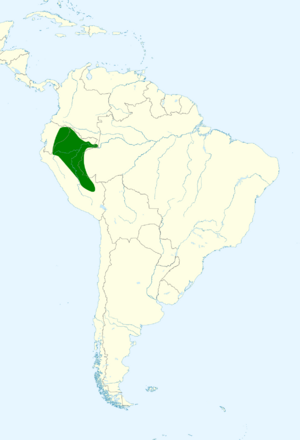Buckley's forest falcon facts for kids
Quick facts for kids Buckley's forest falcon |
|
|---|---|
| Conservation status | |
| Scientific classification | |
| Genus: |
Micrastur
|
| Species: |
buckleyi
|
 |
|
The Buckley's forest falcon (Micrastur buckleyi) is a cool bird of prey. It's also known as the lesser collared forest-falcon or Traylor's forest-falcon. This bird is part of the falcon and caracara family. You can find it in countries like Bolivia, Brazil, Ecuador, and Peru. It might also live in Colombia and Venezuela.
Contents
About This Falcon
Scientists group living things using a system called taxonomy. Buckley's forest falcon was once thought to be a type of collared forest falcon. But now, experts know it's its own unique species. It's closely related to the collared forest falcon and the slaty-backed forest falcon. This falcon is "monotypic," which means it's the only species in its group.
What It Looks Like
Buckley's forest falcon is about 41 to 51 centimeters (16 to 20 inches) long. Its wings can spread out from 61 to 72 centimeters (24 to 28 inches).
- Adult males have black feathers on their upper body. They have a white collar around their neck. Their cheeks, throat, and belly are white with no marks. Their tail is black with thin white stripes.
- Adult females look a lot like males. But they have white spots on their shoulders and wing feathers.
- Young falcons are black on top too. However, their chest is a light brown color, and they have dark stripes on their belly.
All these falcons have dark brown eyes. The skin around their eyes, nose, and mouth is a dull green. Their legs and feet are yellowish.
Where It Lives
Buckley's forest falcon is quite rare. We only know about it from a few birds that have been studied, some photos, and a few sightings. It has been seen in Bolivia, western Brazil, eastern Ecuador, and eastern Peru. There are also a few reports from Colombia and Venezuela. Scientists are still checking if it truly lives in those two countries.
This falcon usually lives in tropical and subtropical forests. It prefers areas between 100 and 700 meters (330 and 2,300 feet) above sea level. But some have been found higher up, like one in Ecuador at 1,800 meters (5,900 feet).
How It Behaves
Moving Around
Scientists believe Buckley's forest falcon stays in the same area all year long. It doesn't seem to migrate or move far away.
What It Eats
We don't know much about what Buckley's forest falcon eats or how it hunts. One bird was found with a small tree rat in its stomach. Because its feet are small, scientists think it probably doesn't eat many birds.
Raising Young
We've seen young falcons that have just learned to fly. This suggests that their breeding season is from April to early August. We don't know much else about how they raise their families. However, like other forest falcons, they probably build their nests inside tree holes.
Its Calls
The most common sound Buckley's forest falcon makes is a loud, nasal "eeok, oow" or "eeok, oow...ow." It repeats this sound for a long time, especially at dawn. It also sometimes makes a long series of rising "kaw" notes, followed by two or three falling "aauw" notes.
Its Future
The IUCN (International Union for Conservation of Nature) says Buckley's forest falcon is a species of "Least Concern." This means it's not currently in immediate danger of disappearing. However, it lives in a small area, and we don't know how many of these birds exist. Scientists think their numbers might be going down.
No big threats have been found for this bird yet. It's not very well known and is considered rare. Even though it's not in immediate danger, its forest home is being cleared in some areas.


